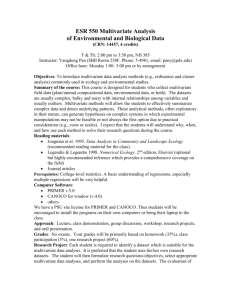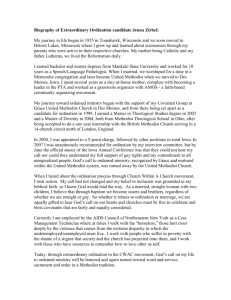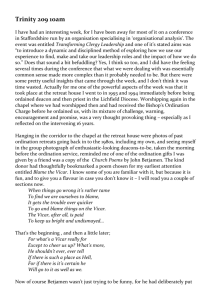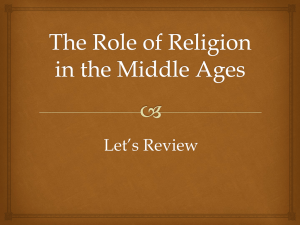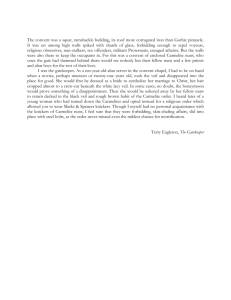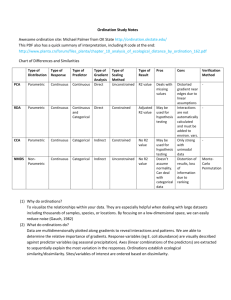Dignity & Discipline: Reviving Full Ordination for Buddhist Nuns.
advertisement
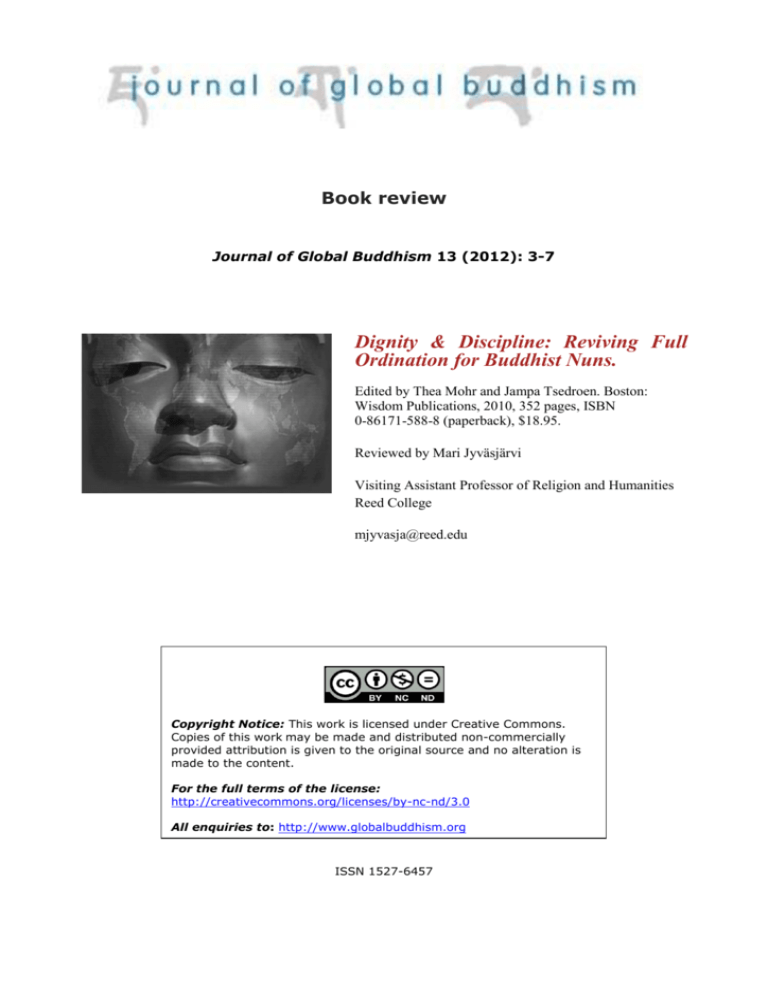
Book review Journal of Global Buddhism 13 (2012): 3-7 Dignity & Discipline: Reviving Full Ordination for Buddhist Nuns. Edited by Thea Mohr and Jampa Tsedroen. Boston: Wisdom Publications, 2010, 352 pages, ISBN 0-86171-588-8 (paperback), $18.95. Reviewed by Mari Jyväsjärvi Visiting Assistant Professor of Religion and Humanities Reed College mjyvasja@reed.edu Copyright Notice: This work is licensed under Creative Commons. Copies of this work may be made and distributed non-commercially provided attribution is given to the original source and no alteration is made to the content. For the full terms of the license: http://creativecommons.org/licenses/by-nc-nd/3.0 All enquiries to: http://www.globalbuddhism.org ISSN 1527-6457 Journal of Global Buddhism Vol. 13 (2012): 3-7 B o o k R e v i e w Dignity & Discipline: Reviving Full Ordination for Buddhist Nuns. Edited by Thea Mohr and Jampa Tsedroen. Boston: Wisdom Publications, 2010, 352 pages, ISBN 0-86171-588-8 (paperback), $18.95. Reviewed by Mari Jyväsjärvi I n July 2007, an unprecedented event in the history of Buddhism took place when Buddhist scholars, monastics, and representatives of various Buddhist organizations gathered in Hamburg for the International Congress on Women's Role in the Sangha. The goal was to bring together the leading experts on Buddhist monastic discipline and history to assess the possibility of restoring the full ordination lineage for Buddhist nuns. The papers addressed the history of women's monastic practice in Buddhism, the ordination procedures in the various Vinayas, the legality of restoring the bhiksunī ordination, and the possible ways in which this could be carried out. The congress concluded with a statement by His Holiness the Dalai Lama. A selection of the papers delivered at this momentous gathering have been compiled and edited by Thea Mohr and Jampa Tsedroen under the title Dignity & Discipline: Reviving Full Ordination for Buddhist Nuns. While full ordination is available to women in East Asian Buddhist traditions, in the Tibetan and Theravāda Buddhist traditions the lineage of fully ordained nuns (bhiksunī/bhikkhunī) has died out. Reviving it is not a simple matter, since ordination of new nuns requires a quorum of already existing fully ordained nuns performing the rite alongside monks. Various initiatives have nevertheless been made in recent decades, both in Asia and in the West, to achieve this goal. What made the Hamburg conference so unique is that it constituted a public dialogue on a global scale: it brought together Buddhist scholars and practitioners, Asian and Western, across sectarian boundaries, to discuss a shared and pressing concern that has larger implications for how Buddhism will adapt to changing socio-historical contexts. At the same time, as the papers collected in this volume attest, the issue of restoring the ordination lineage is an extremely complex one. Apart from the question of legality, there are diverse and often conflicting views and agendas at play. Contested topics include the compatibility of feminism and Buddhism, the validity of ordinations co-conducted by members of different Vinaya schools, and the place of archaic rules such as the notorious eight gurudharmas in twenty-first century Buddhist communities. In the opening essay, Janet Gyatso frames the debate in larger terms, reflecting on the moral and political implications of this historic juncture for Buddhism. While the matters of legality and precedent are obviously important, she states, "the more germane question has to do with desire, consensus, and will" (7). Throughout Buddhist history, the Vinaya has been modified and changed in response to changing historical and cultural circumstances, through consensus and political will. The case of women's full ordination, Gyatso proposes, is likely to be similar. In fact, if Buddhist communities do not address the patriarchy, androcentrism, and misogyny within their tradition, "there is little chance for Buddhism to take up the role that it is poised to JOURNAL OF GLOBAL BUDDHISM /4 assume in the modern world" (17). This is a sentiment echoed by many of the other contributors. Gyatso concludes by boldly envisioning what a future with a strong, vibrant order of fully ordained Buddhist nuns might look like, and how they might contribute to current global issues. In "The Vinaya Between History and Modernity: Some General Reflections," Jens-Uwe Hartmann makes the sobering observation that academic analysis may not be able to provide the kind of conclusive proof needed to make the case for women's full ordination. Historians and textual scholars view the Vinaya rather differently than most Buddhist practitioners, so the former may not be able to offer any legally applicable findings that the latter would find binding. Moreover, Hartmann asks, is it even possible to obtain any kind of positive proof that would be applicable for all time, given that the history of the Vinaya spans 2,500 years, much of it unrecorded? Bhikkhu Sujato's contribution, "Sects and Sectarianism," discusses the historical relationships among the three currently existing Vinaya lineages: Theravāda, Dharmaguptaka, and Mūlasarvāstivāda. He concludes that, since all three derive from the Sthavira school, and the Theravāda and Dharmaguptaka in particular have few significant divergences in terms of doctrine and Vinaya procedures, the argument against Theravāda or Mūlasarvāstivāda nuns receiving a Dharmaguptaka ordination on sectarian grounds is hardly valid. Gisela Krey's article points out inconsistencies in the narrative about the Buddha's hesitation to grant ordination to women, arguing that "the Buddha had no intention of excluding women from the path of going forth" (55). She briefly discusses the interesting references to the so-called "ehi formula" being applied to nuns in the Pāli canon. Krey follows the argumentation of an earlier article by Liz Williams, and much of her article in fact reads like a summary of Williams' points. In "Women's Renunciation in Early Buddhism," Anālayo analyzes an impressive array of lesser-known passages from the Pāli suttas and their Chinese and Sanskrit parallels to assess the Buddha's attitude towards the order of nuns. He points out that the Buddha's supposed refusal to ordain women, as well as his prophecy that dharma will decline after 500 years if women are ordained, are inconsistent with other passages where, soon after his awakening, he decides to establish four assemblies of disciples (including nuns), just as all the Buddhas before him. As a part of the fourfold assembly, the nuns were an integral part of the early Buddhist monastic community, and innumerable passages describe the meritorious qualities of outstanding, learned nuns. Inconsistencies in the formulation of the eight gurudharmas also suggest, according to Anālayo, that these rules were probably not promulgated when the first nuns were ordained. These and similar examples give him grounds to conclude that "the elements in the canonical accounts that express a negative attitude toward nuns seem to stem from a later textual layer" (96). In "The Eight Garudhammas," Ute Hüsken also underlines the inconsistencies in the Pāli account of the foundation of the nuns' order. Not only are many of the eight heavy rules incongruent with parallel rules in the Bhikkhunīvibha.nga, but many of them also violate the time-frame of the very story in which they are introduced. Like Anālayo, Hüsken concludes that Review: DIGNITY & DISCIPLINE: REVIVING FULL ORDINATION FOR BUDDHIST NUNS /5 the eight rules, rather than uttered by the Buddha, reflect the views and agendas of later redactors. Bhikkhu Bodhi's contribution considers the arguments for and against the current revival of bhikkhunī ordination in the Theravāda tradition. Engaging both sides, and drawing on textual and ethical considerations, he argues that both the ancient mandate of the Buddha's decision to ordain nuns, and compelling contemporary circumstances support the resuscitation of bhikkhunī ordination. Dhammananda Bhikkhunī, in turn, provides a helpful discussion of the current challenges faced by nuns in Thailand. The few fully ordained Thai bhikkhunīs receive neither official recognition nor government support. Dhammananda goes over some of the most common misconceptions that conservative monks, in particular, use to justify their lack of interest in reinstituting full ordination for nuns in Thailand, and responds to them one by one. Tashi Tsering's "A Lamp of Vinaya Statements: A Concise Summary of Bhiksunī Ordination" is particularly relevant for the question of reviving full ordination in the Mūlasarvāstivāda tradition. As the title suggests, it compiles Tibetan canonical and commentarial passages on this topic, reflecting the thorough research the author has carried out for the Department of Religion and Culture of the Central Tibetan Administration. He identifies an interesting loophole in the texts: if a woman is ordained through the ordination rite of the monks, or a man ordained by that of nuns, the ordination is considered valid; those who conduct it simply commit a minor infraction. Thus, a new bhiksunī order could be started by simply ordaining the first bhiksunīs through the ordination rite of a bhiksu. Thubten Chodron, in turn, makes the case that ordination of nuns by a mixed sangha consisting of monastics from two different Vinaya lineages should not present a problem. She finds a precedent for such a procedure in the ordination of the ninth-century monk Lachen Gongpa Rapsal, who was ordained by three Tibetan (Mūlasarvāstivāda) monks and two (most likely Dharmaguptaka) Chinese monks, when there were not enough Tibetan monks to perform the full ordination rite. Damchö Diana Finnegan examines the narratives of women's ordinations in the Mūlasarvāstivāda Vinaya, arguing that these narratives are "of great value in assessing a permissible degree of flexibility in implementing the procedural rules for ordination" (196). In her two examples, the stories of Kacangalā and Utpalavarnā, we see a concern not with following the established rules and rituals precisely, but rather with making a particular woman's ordination socially acceptable. The stories also often present the nuns as the main agents of ensuring the ordination of other nuns. In "Creating Nuns Out of Thin Air," Shayne Clarke presents a number of cases from the Mūlasarvāstivāda Vinaya where an ordination ritual does not proceed exactly according to the rulebooks, but the Buddha nevertheless declares it to be valid. Introducing cases where, for example, ordination through a lay preceptor, full ordination with no preceding pravrajyā initiation, or a nun's ordination through the formal act of a monk are all considered valid, Clarke urges us to distinguish between "ideal" ordinations and "acceptable" ones. JOURNAL OF GLOBAL BUDDHISM /6 It is not possible, within the limits of this review, to do full justice to all the contributions and examine them in detail. Lobsang Dechen's brief essay on the current state of Tibetan nuns in exile connects the issue of ordination to that of education, arguing that "because nuns have been unable to study all the Vinaya texts, they have often lacked confidence when discussing the possibilities for bhiksunī ordination" (209). David Jackson's examination of the two distinct ordination lineages in the Śākya school of Tibetan Buddhism, while not directly relevant to the issue of nuns' ordination, does offer a precedent for purposefully manipulating the ordination procedures when necessary. Petra Kieffer-Pülz lays a valuable groundwork for possible future ordinations performed by a joint sangha consisting of Mūlasarvāstivāda and Dharmaguptaka monastics by examining the two traditions' mutual compatibility in terms of ordination procedures, and their potential for judging each other’s ordination lineage as valid. Jan-Ulrich Sobisch, in turn, points out that the question of nuns' full ordination is not only a legal problem, but also a matter of authority and power. He reviews some views of how authority is transmitted in Tibetan Buddhist lineages, although the relevance of this discussion for the topic of this book is not clear. Karma Lekshe Tsomo's essay examines the question of the nuns’ status from the broader point of view of human rights and gender equity. The penultimate chapter compiles the formal statements made by several senior monks and nuns to His Holiness the Dalai Lama on the last day of the conference, his response, and a question-and-answer session. All monastics unanimously express their support for reinstituting the bhiksunī ordination; the only disagreements are regarding the exact method by which this should be done. In his response, His Holiness calls for patience, stressing that he cannot act alone: an official change in the procedures necessitates the consensus of the senior monks. In his concluding formal statement, however, His Holiness expresses his stance in clear terms: "I express my full support for the establishment of the bhiksunī sangha in the Tibetan tradition" (179). Dignity & Discipline thus documents an important and unique moment in Buddhist history. Overall, the editors have been successful in creating a readable volume that works as a whole, although—as is always the case with edited volumes of conference proceedings—the quality of the articles varies, and the topics and approaches vary vastly from paper to paper. It would have been helpful to arrange the essays under thematic sub-headings, so that text-historical investigations of the Vinayas, for example, would be grouped together, and contributions describing the contemporary situation of Thai or Tibetan nuns would follow one another, creating greater coherence and a sense of dialogue among the individual pieces. Moreover, since the book seeks to document the debate, or controversy, around the issue of women's full ordination, it would have been interesting to include some of the more conservative voices, allowing ordination opponents to express their views in their own terms. Finally, the book does not respond in any satisfying way to the thorny question raised by Gyatso (p. 14-16): Can the eight heavy rules—a blatant enshrinement of patriarchy and the greatest detriment to any possibility of nuns and monks ever having equal status and prestige—be modified, or left out entirely, in twenty-first century bhiksunī ordinations? There is, of course, the larger question about whether a book such as this, or the congress it documents, will ultimately prove effective in bringing about real change in communities on the ground. Recall Gyatso's point that consensus and political will have often been seen to bring about changes in monastic procedures, irrespective of legal and scholarly pronouncements. Review: DIGNITY & DISCIPLINE: REVIVING FULL ORDINATION FOR BUDDHIST NUNS /7 There is no question, to my mind, that the bhiksunī ordination lineage will be re-established and come into its own in the years to come. Perhaps the best testimony to this book's success will be, ironically, that it will soon appear dated, a relic from a bygone era when women's eligibility for full ordination was still a debated issue.

